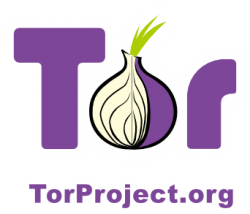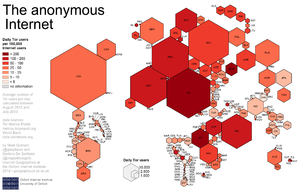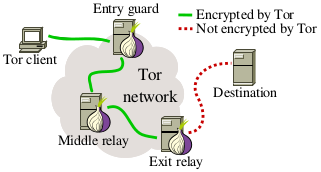Tor
 | |
| Type | software |
| Start | 2002-09-20 |
| Interest of | • Jacob Applebaum • Roger Dingledine • Matt Edman • Yasha Levine • John Young |
| A piece of software which claims to offer security an privacy online. | |
Tor is an acronym from The Onion Router.
Contents
Official narrative
TOR directs Internet traffic through a free, worldwide, volunteer network consisting of over 6000 relays. It is routed through several such routers, and users strong cryptography which provides effective anonymity. An extract of a Top Secret appraisal by the NSA characterized Tor as "the King of high-secure, low-latency Internet anonymity" with "no contenders for the throne in waiting".[1]
History

The core principle of Tor, "onion routing", was developed in the mid-1990s by United States Naval Research Laboratory employees, mathematician Paul Syverson and computer scientists Michael G. Reed and David Goldschlag, with the purpose of protecting U.S. intelligence communications online. Onion routing was further developed by DARPA in 1997.[2][3][4]
The alpha version of Tor, developed by Syverson and computer scientists Roger Dingledine and Nick Mathewson[5] and then called The Onion Routing project, or TOR project, launched on 20 September 2002. On 13 August 2004, Syverson, Dingledine and Mathewson presented "Tor: The Second-Generation Onion Router" at the 13th USENIX Security Symposium. In 2004, the Naval Research Laboratory released the source code for Tor under a free licence, and the Electronic Frontier Foundation (EFF) began funding Dingledine and Mathewson to continue its development.[5]
Hacks
TOR routes internet traffic through many computers and uses multiple layers of cryptography. The last step (handled by an exit node) is of qualitatively different to the other steps. A lot of attacks against the Tor software focus on exit nodes.
In 2013, Gizmodo reported that the FBI admitted "hacking into the tor network" to collect users' IP addresses.[6]
In 2015, Roger Dingledine directly accusing Carnegie Mellon of providing its Tor-breaking research in secret to the FBI in exchange for a payment of “at least $1 million.”[7]
Matt Edman, who worked with the Tor Project for a year until 2009, was subsequently employed by a defence contractor working for the FBI to develop anti-Tor malware.[8]
Wikileaks
Julian Assange, who founded Wikileaks stated in 2006 that he had already "received over one million documents from 13 countries". The New Yorker and then Wired both claimed that these were not knowingly submitted to the site, but captured by him since as he ra a modified Tor exit node, and the documents had been entrusted to the Tor network.[9][10] Asked to clarify whether this was true by The Register, Assange denied the charge, stating that "The imputation is incorrect. The facts concern a 2006 investigation into Chinese espionage one of our contacts were involved in. Somewhere between none and handful of those documents were ever released on WikiLeaks. Non-government targets of the Chinese espionage, such as Tibetan associations were informed (by us)."[11]
Malicious Tor Nodes
In July 2016, researchers announced that over 72 days they had found at least 110 malicious Tor nodes which were spying on hidden services.[12]
Concerns
Although Tor is an open source project, the history of the software, its popularity - and the fact that the US government continues to fund it - raises a major red flag. Several individual hackers have developed methods to somewhat compromise the supposed anonymity it provides, and its does not seem unlikely that the NSA has a suite of software designed to unmask Tor users. If this is in fact the case, then Tor is in fact worse than useless, as it draws attention to the user.[13][14][15]
A Tor victim on Wikispooks
| Title | Description |
|---|---|
| Dilawar | A taxi driver who was in the wrong place at the the wrong time. Tortured while in US custody and dead within the week. A leaked autopsy revealed "homicide", but the US authorities have not taken any action in this regard. |
Related Quotations
| Page | Quote | Author | Date |
|---|---|---|---|
| Cryptome | “Cryptome raises serious questions that nobody else on the left or in the media want to talk about, including how Omidar has created a business from Snowden's cache; what exactly Snowden may have been doing while he was working for the CIA prior to his time at NSA (and what else he may have been doing at NSA itself); and why Snowden and The Intercept continue to proselytize for Tor, the anonymization tool, despite its massive funding from the U.S. government, the Pentagon and the national security state.” | Tim Shorrock | February 2016 |
| Roger Dingledine | “The United States government can’t simply run an anonymity system for everybody and then use it themselves only. Because then every time a connection came from it people would say, “Oh, it’s another CIA agent.” If those are the only people using the network.”” | Roger Dingledine | 2004 |
References
- ↑ http://www.theguardian.com/world/interactive/2013/oct/04/tor-high-secure-internet-anonymity
- ↑ Fagoyinbo, Joseph Babatunde (2013-05-24). The Armed Forces: Instrument of Peace, Strength, Development and Prosperity. AuthorHouse. ISBN 9781477226476. Retrieved 29 August 2014.Page Module:Citation/CS1/styles.css must have content model "Sanitized CSS" for TemplateStyles (current model is "Scribunto").
- ↑ Leigh, David; Harding, Luke (2011-02-08). WikiLeaks: Inside Julian Assange's War on Secrecy. PublicAffairs. ISBN 1610390628. Retrieved 29 August 2014.Page Module:Citation/CS1/styles.css must have content model "Sanitized CSS" for TemplateStyles (current model is "Scribunto").
- ↑ Ligh, Michael; Adair, Steven; Hartstein, Blake; Richard, Matthew (2010-09-29). Malware Analyst's Cookbook and DVD: Tools and Techniques for Fighting Malicious Code. John Wiley & Sons. ISBN 9781118003367. Retrieved 29 August 2014.Page Module:Citation/CS1/styles.css must have content model "Sanitized CSS" for TemplateStyles (current model is "Scribunto").
- ↑ a b
{{URL|example.com|optional display text}} - ↑ http://gizmodo.com/the-fbi-just-admitted-to-hacking-into-the-tor-network-1310273550
- ↑ http://www.wired.com/2015/11/tor-says-feds-paid-carnegie-mellon-1m-to-help-unmask-users
- ↑ http://www.techeye.net/news/tor-developer-helps-spooks-hack-tor
- ↑ http://www.newyorker.com/magazine/2010/06/07/no-secrets
- ↑ http://www.wired.com/2010/06/wikileaks-documents/
- ↑ http://www.theregister.co.uk/2010/06/02/wikileaks_tor_snooping_denial/
- ↑ https://motherboard.vice.com/read/over-100-snooping-tor-nodes-have-been-spying-on-dark-web-sites
- ↑ http://www.zdnet.com/article/fbi-used-hacking-team-services-to-unmask-tor-user/#!
- ↑ https://hackertarget.com/tor-exit-node-visualization/
- ↑ http://motherboard.vice.com/en_ca/read/badonion-honeypot-malicious-tor-exit-nodes
